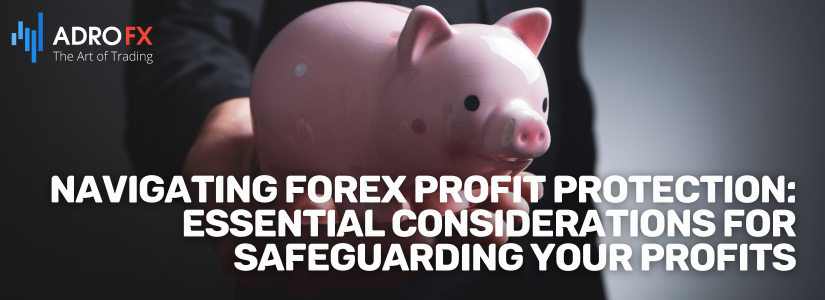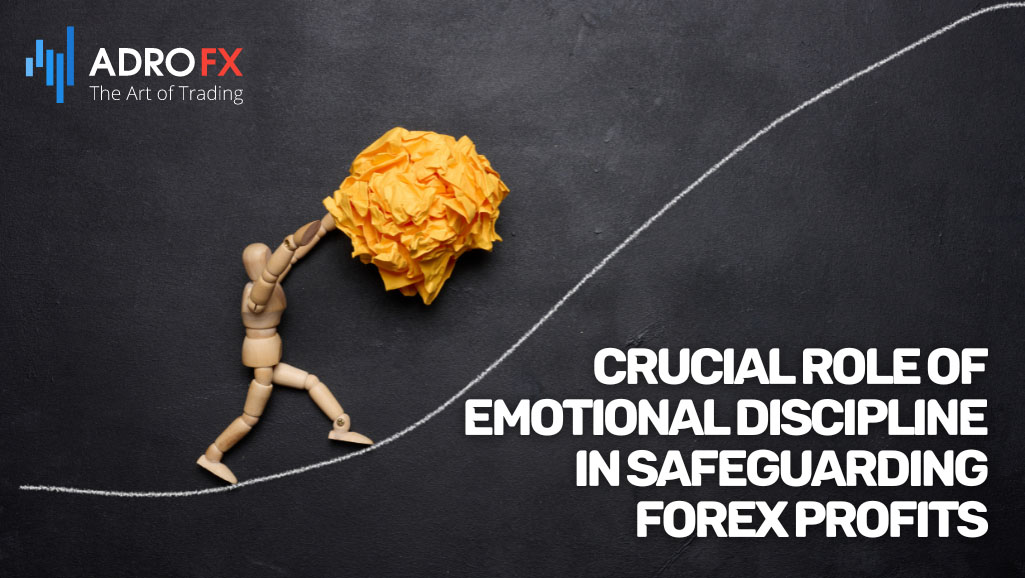Navigating Forex Profit Protection: Essential Considerations for Safeguarding Your Profits

Embarking on the thrilling journey of forex trading promises excitement and potential profits, accompanied by the inherent risks of a volatile market. In this dynamic landscape, the significance of risk management cannot be overstated. The imperative role it plays in minimizing losses and maximizing gains forms the backbone of a trader's success. This article delves into the multifaceted strategies that comprise sufficient risk management, ranging from Stop Loss orders and position sizing to diversification and adherence to a well-defined trading plan.
The Imperative Role of Risk Management
Engaging in forex trading offers the allure of excitement and potential profits, yet it entails inherent risks. Amidst the volatile and unpredictable nature of the forex market, the importance of risk management cannot be overstated. Effectively using risk management approaches is pivotal in minimizing losses and maximizing earnings.
Why does it play a vital role in safeguarding forex profits? The forex market's rapid and unpredictable price fluctuations pose a considerable threat. Without prudent risk management, substantial portions of your investment may be at risk. This is where the significance of risk management strategies becomes evident.
A fundamental step in effective risk management is the establishment of a Stop Loss order. This predefined level dictates when you close a trade if the market changes direction against you. Placing a Stop Loss order serves to limit potential losses and safeguard your profits. It is crucial to determine this level based on your trading system and risk tolerance.
Position sizing is another critical factor in protecting forex profits. It involves allocating a specific amount of money to each trade. Risking only a small portion of your trading deposit on each trade ensures that even a series of losses won't deplete your account. Proper position sizing acts as a shield for your profits, ensuring sufficient capital for continuous trading.
Diversification serves as an additional layer of protection. Instead of concentrating all your investments on one currency pair, spreading risk across different pairs can prevent catastrophic losses. Diversification helps safeguard your forex returns by mitigating the impact of any adverse movement in a single trade on your overall portfolio.
Beyond diversifying trades, diversifying trading strategies is equally important. Different strategies excel in varying market conditions. Possessing a repertoire of strategies allows you to adapt to altering market dynamics and protect your profits effectively.
Lastly, having a well-defined trading plan is imperative. It outlines your goals, risk tolerance, and trading strategy. It acts as a guiding framework, fostering discipline and preventing impulsive decisions driven by emotions. Adhering to your trading plan ensures protection for your profits by following a proven strategy and dodging excessive risks.
In conclusion, safeguarding forex profits hinges on effective risk management. Implementing strategies such as Stop Loss orders, prudent position sizing, diversification of trades and strategies, and adherence to a well-structured trading plan minimizes losses and maximizes gains. While forex trading isn't a shortcut to wealth, diligent risk management significantly enhances the chances of sustained success in the long term.

Strategic Approaches to Setting Stop Loss Orders
Preserving hard-earned profits in the dynamic realm of forex trading demands a nuanced strategy, with the implementation of Stop Loss orders standing out as a powerful approach. These risk management tools empower traders to establish predetermined exit points, automatically closing trades when prices hit the set Stop Loss level, thereby limiting potential losses.
Crafting an effective approach to setting Stop Loss orders requires meticulous consideration of several key factors. Foremost among them is understanding and defining your risk tolerance - a critical aspect that demands a realistic and honest assessment of the amount you're willing to risk on a trade. Striking the right balance is crucial, avoiding the pitfalls of setting Stop Loss orders either too close, risking premature exits, or too far away, exposing you to larger losses than manageable.
The volatility of the currency pair being traded is another pivotal factor shaping your Stop Loss strategy. Highly volatile pairs necessitate wider Stop Loss orders to accommodate significant price swings, while less volatile pairs may require tighter parameters. Tailoring your approach based on the specific currency pair's volatility ensures a more precise risk management strategy.
Equally important is considering the timeframe of your trades. Different timeframes exhibit varying levels of volatility, prompting adjustments to Stop Loss orders. For instance, shorter time frames, like the 5-minute chart, might need tighter Stop Loss orders analogized to longer-term charts such as the daily chart.
Anticipating and accounting for upcoming news or events is a prudent step in this strategy. News releases have the potential to trigger substantial price movements, justifying the setting of wider Stop Loss orders during these periods. In some cases, avoiding trading altogether during major news releases may be a strategic move to shield profits.
The final key element in this strategic approach is the regular review and adjustment of Stop Loss orders. The dynamic nature of the forex market demands continuous adaptation. What may have been a suitable Stop Loss level before may not be appropriate today. Consistent monitoring and adjustments ensure that your profits are shielded in the face of changing market conditions.
In conclusion, setting Stop Loss orders is an indispensable strategy for protecting forex profits. Traders can effectively safeguard their profits by carefully considering risk tolerance, currency pair volatility, time frame, news releases, and consistently reviewing and adjusting orders. Remember, protecting profits is as vital as earning them, making the incorporation of strategic Stop Loss approaches an essential aspect of successful forex trading.

The Crucial Role of Emotional Discipline in Safeguarding Forex Profits
While robust risk management strategies and diversified portfolios form essential pillars of profit protection in forex trading, the often-overlooked element of emotional discipline plays a pivotal role in ensuring long-term success and safeguarding profits.
The forex market, characterized by its inherent volatility, can evoke emotional responses that may lead to impulsive decisions. Fear, greed, and anxiety are emotions that, if left unchecked, can undermine even the most meticulously crafted trading plans. Emotional discipline involves cultivating the ability to manage these emotions, allowing traders to stick to their strategies and navigate the market with a clear and rational mindset.
One aspect of emotional discipline is maintaining composure in the face of market fluctuations. Rapid price movements and unexpected events can trigger emotional responses that may lead to hasty decision-making. Traders with emotional discipline can resist the urge to deviate from their trading plan and succumb to impulsive actions.
Patience is another key component of emotional discipline. Forex trading is a long-term endeavor, and profits are often the result of a series of well-executed trades over time. Impatience can lead to premature exits or entries, jeopardizing potential profits. Traders who cultivate emotional discipline understand the importance of patience and allow their trades to unfold according to plan.
Additionally, emotional discipline involves the ability to accept losses gracefully. Not every trade will be a winner, and setbacks are an inherent part of trading. Traders with emotional discipline do not let losses dictate their mindset; instead, they view losses as learning opportunities and remain focused on their long-term objectives.
To cultivate emotional discipline, traders can employ various practices, including mindfulness techniques, regular self-reflection, and maintaining a healthy work-life balance. These practices contribute to a trader's mental resilience, enabling them to withstand the psychological challenges of forex trading.
In conclusion, emotional discipline is a critical factor in the overall framework of safeguarding forex profits. It complements risk management strategies and diversification efforts by ensuring that traders make decisions based on rational analysis rather than emotional reactions. By cultivating emotional discipline, traders can fortify their resilience in the face of market uncertainties, ultimately contributing to sustained success in the dynamic world of forex trading.
Conclusion
In the intricate world of forex trading, the pursuit of profit protection is a strategic imperative. Beyond the allure of financial gains lies the need for a comprehensive approach to risk management. By integrating strategies like Stop Loss orders, prudent position sizing, diversification, and commitment to a structured trading plan, traders fortify their defenses against market uncertainties. The quest for forex success is not merely about earning profits; it's about protecting them, and diligent risk management stands as the key to enduring success in this dynamic realm.
About AdroFx
Established in 2018, AdroFx is known for its high technology and its ability to deliver high-quality brokerage services in more than 200 countries around the world. AdroFx makes every effort to keep its customers satisfied and to meet all the trading needs of any trader. With the five types of trading accounts, we have all it takes to fit any traders` needs and styles. The company provides access to 115+ trading instruments, including currencies, metals, stocks, and cryptocurrencies, which make it possible to make the most out of trading on the financial markets. Considering all the above, AdroFx is the perfect variant for anyone who doesn't settle for less than the best.










